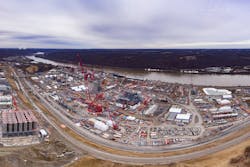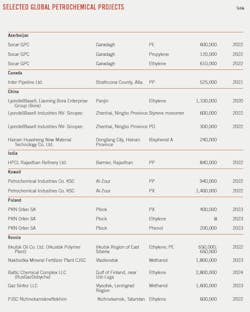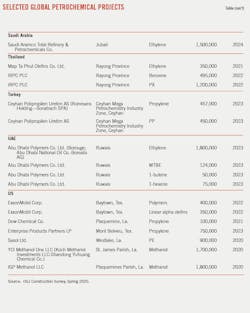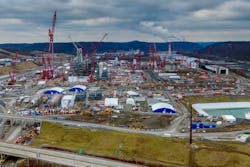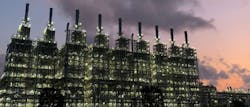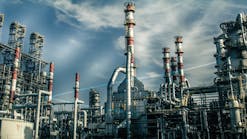Petrochemical operators advance most projects despite delays, slowed investments
The global outbreak and as-yet uncontrolled spread of coronavirus (COVID-19) during first-half 2020 has forced many downstream operators to scale back plans and budgets for previously announced major projects. While refiners have been hit hardest, given the uncertainty as to when demand for transportation fuels will return to pre-COVID-19 levels, petrochemical operators have fared slightly better as demand for materials used to produce hygiene-related products such as personal protective gear, packaging, medical equipment, detergents, and disinfectants has cushioned immediate blows to cash flow.
With industry still yet to reach a consensus as to when and to what degree downturn demand will fully impact the chemicals sector, more-cautious petrochemical producers already have announced decisions to delay projects, particularly those still in early development at the onset of the health crisis. Based on longer-term outlooks of demand for petrochemicals becoming the largest driver of global oil consumption from the International Energy Agency and various industry analysts, however, many other operators are forging ahead with investment projects, with some announcing major development plans even during the current health crisis.
This article examines COVID-19’s effect on the status of notable, previously announced major petrochemical projects and presents a selection of recently launched projects now in development despite the pandemic.
Project delays
Confirmable delays to major petrochemical plans largely involve US-based projects originally developed to benefit from cheaper feedstock supplies sourced from abundant North American shale production, the reliability of which during the lower-for-longer oil price environment of COVID-19 has drastically eroded.
In June 2020, PTTGC America LLC (PTTGCA), the US subsidiary of Thailand’s PTT Global Chemical (PTTGC) and partner Daelim Chemical USA LLC of South Korea, said it would delay final investment decision (FID) on the partnership’s (PTTDLM) proposed 1.5-million tonne/year (tpy) ethane cracker and petrochemical complex planned for Mead Township along the Ohio River in Shadyside, Belmont County, Ohio, by 6-9 months (OGJ Online, June 8, 2020; Apr. 29, 2020). PTTGCA—which previously warned of a delayed project FID in April 2020 following its February completion of first-phase site preparation, engineering, and design work—now plans to reach FID either by end-2020 or sometime in first-quarter 2021.
According to a final air pollution permit-to-install issued in December 2018 by the Ohio Environmental Protection Agency, PTTDLM’s proposed multi-billion-dollar complex—which will be equipped with six ethane-cracking furnaces—will produce ethylene, high-density polyethylene (HDPE), and linear low-density polyethylene (LLDPE) using the following units and capacities:
- Ethylene plant, 1.5 million tpy.
- HDPE Unit 1, 350,000 tpy.
- HDPE Unit 2, 350,000 tpy.
- LLDPE-HDPE Unit 1, 450,000 tpy.
- LLDPE-HDPE Unit 2, 450,000 tpy.
FG LA LLC, a subsidiary of Taiwan Formosa Plastics Group’s Formosa Petrochemical Corp., said on June 24, 2020, that it will begin preconstruction activities this summer on its proposed $9.4-billion Sunshine ethane cracking and petrochemical complex along the west bank of the Mississippi River in St. James Parish, La., following a halt to development forced by the COVID-19 outbreak in March 2020 (OGJ Online, Apr. 24, 2018).
The complex—which FG LA confirmed received its final permits to construct from the Louisiana Department of Environmental Quality in January 2020—will be built in two phases over a 10-year period. Phase 1 of the complex will include an ethylene plant and associated polymer plants; an ethylene glycol (EG) plant; a propylene plant and associated polymer plant; and ancillary support installations for product loading and utilities, including electricity and wastewater treatment. Phase 2 will add another ethylene plant, associated polymer plants, and second EG plant, according to FG LA.
While FG LA confirmed plans to immediately advance a series of preconstruction activities on Sunshine, the operator has yet to disclose proposed production capacities for the project or a definitive timeframe for when it will reach FID on the development.
On Mar. 18, 2020, Royal Dutch Shell PLC said threat of the spreading COVID-19 virus forced it to temporarily halt construction activities at Shell Chemical Appalachia LLC’s greenfield petrochemical complex under construction along the Ohio River in Potter Township, Beaver County, Pa., about 30 miles northwest of Pittsburgh (OGJ Online, Oct. 10, 2018). While Shell has yet to directly confirm restart of construction, posts to the company’s various official social media sites indicate workers have gradually returned to work (Fig. 1). Designed to produce ethylene and PE from nearby supplies of low-cost Marcellus and Utica shale ethane, Shell’s Appalachian petrochemical complex—for which Bechtel Corp. is serving as main works contractor for construction—will include an ethane cracker with an average ethylene production capacity of about 1.5 million tpy, three PE units with a combined production of 1.6 million tpy, and associated installations for power and steam generation, storage, logistics, and cooling water and water treatment. Two of the complex’s PE units will manufacture high-density PE grades of pellets, while a third PE unit will produce LLDPE pellets. The complex remains on schedule to begin commercial production sometime during 2020-21, Shell said in its latest update to investors on projects under construction.
In late March 2020, LyondellBasell Industries NV said it was slowing construction on what it is calling the world’s largest propylene oxide (PO) and tertiary butyl alcohol (TBA) plant at the company’s Houston-area complex in Channelview, Tex., due to ongoing concerns related to the COVID-19 pandemic (OGJ Online, Mar. 31, 2020). The announced setback came just a month after LyondellBasell confirmed that construction progess on the overall PO-TBA project—which broke ground August 2018—had surpassed 30% after the late-2019 completion of first-phase construction (OGJ Online, Feb. 20, 2020). Once in operation, the 140-acre PO-TBA plant in Channelview will produce 1 billion lb/year of PO and 2.2 billion lb/year of TBA, the latter of which will move to an associated 34-acre ethers unit to be built at the company’s Bayport complex near Pasadena for conversion into high-octane gasoline components methyl tertiary butyl ether and ethyl tertiary butyl ether. In its first-quarter 2020 earnings report to investors, LyondellBasell said it expects the PO-TBA project to be completed sometime in 2022.
Elsewhere in North America, Canada Kuwait Petrochemical Corp. (CKPC), a joint venture of Pembina Pipeline Corp., Calgary, and Petrochemical Industries Co. KSC (PIC) of Kuwait, faces an indefinite delay to development of its proposed 550,000-tpy integrated propane dehydrogenation (PDH) and polypropylene (PP) complex in Sturgeon County, Alta., despite an early 2020 contract award to Heartland Canada Partners—a 50-50 partnership between Fluor Canada Ltd. and Kiewit Construction Services ULC—to provide engineering, procurement, and construction (EPC) for one of the project’s major units (OGJ Online, Jan. 13, 2020). In response to the COVID-19 pandemic, the subsequent decline in global energy prices, and uncertainty as to the duration of this downturn, partner Pembina said in a Mar. 18, 2020, release that it was deferring its $2.7 billion (Can.) investment in the $4.5-billion project until “global energy prices and the broader economic environment support such action.” The project—on which construction was scheduled to begin later this year—originally was due for mechanical completion in second-half 2023.
The COVID-19 crisis also has prompted unconfirmed speculation from industry analysts regarding other major petrochemical projects announced shortly ahead of the global pandemic.
Chevron Phillips Chemical Co. LLC (CP Chem)—a joint venture of Chevron Corp. and Phillips 66—and Qatar Petroleum (QP) signed an agreement to jointly develop of a new $8-billion petrochemical plant at the US Gulf Coast (OGJ Online, July 10, 2019). To be known as the USGC II, the complex will include a 2-million tpy ethylene cracker and two 1-million tpy high-density HDPE units. CP Chem and QP, which would own 51% and 49%, respectively, planned to take FID on the project no later than 2021, followed by full funding and award of EPC contracts, for a targeted startup in 2024. While the companies did not disclose a specific site for the proposed complex, they reiterated that its USGC location would offer direct access to abundant Permian basin NGL reserves. The proposed USGC joint venture follows CP Chem and QP’s signing of a June 2019 agreement to develop, build, and operate a petrochemicals complex in Ras Laffan Industrial City, Qatar, to produce ethylene and HDPE (OGJ Online, June 24, 2019). The Ras Laffan project—of which QP will own 70% and CP Chem the remaining 30%—would include a 1.9-million tpy ethane cracker as well as two HDPE derivative units with a combined capacity of 1.68 million tpy for commissioning in late 2025.
Dow Inc. announced in February 2020 that it was planning to move forward with a project to incrementally expand ethylene capacity at subsidiary Dow Chemical Canada ULC’s (Dow Canada) petrochemicals manufacturing site just north of Fort Saskatchewan, Alta. Known as the FS1 project, the expansion will involve increasing capacity of the ethylene plant by about 130,000 tpy with the addition of another furnace (OGJ Online, Feb. 4, 2020). Scheduled for startup during first-half 2021, additional ethylene produced by the $200-225-million expansion will be consumed by existing PE assets in the region. While Dow—which planned to co-invest in the expansion with an unidentified regional customer, evenly sharing project costs and ethylene output—has yet to directly confirm the current status of the FS1 project following the COVID-19 outbreak, work on the expansion remains under way, with the project still on schedule for commissioning in 2021, according to Dow Chemical’s website.
In the operator’s Apr. 30, 2020, quarterly earnings call with investors, Dow did confirm it completed its previously announced project to expand the 1.5-million tpy TX-9 ethylene cracker at the operator’s olefins manufacturing complex in Freeport, Tex., by 500,000 tpy during the first quarter, bringing the Freeport cracker to its new operating capacity of 2 million tpy (Fig. 2).
To date, only one major project has officially become a casualty of the global pandemic. In late May 2020, Borealis AG and Kazakh state-owned partner United Chemical Co. LLP (UCC) canceled plans for joint development of an integrated ethane cracker and PE project in Kazakhstan (OGJ Online, May 27, 2020). Borealis said the decision to cancel the project was based on a thorough assessment of all aspects of the proposed venture, including both near-term impacts of COVID-19 and the pandemic’s role in increasing uncertainty regarding future market assumptions. Cancellation of the project follows a 2018 joint development agreement signed by Borealis and UCC, under which the partners planned to build an ethane cracker and two PE units based on Borealis’ proprietary Borstar PE process at the proposed Kazakhstan complex, which—due for FID this year and scheduled for startup in 2025—was to have an overall production capacity of 1.25 million tpy.
Plans advance
Despite sizeable cuts to some pre-COVID-19 capital spending programs, most major chemical projects appear to be advancing on pace, with some operators revealing plans for new developments during the global outbreak.
As demand begins a modest recovery and populations continue to grow in the Asia Pacific, regional petrochemical producers are proceeding with expansion plans seemingly undeterred by future demand concerns resulting from the pandemic.
In late June 2020, Zhejiang Petroleum & Chemical Co. Ltd., also known as Zhejiang Petrochemical Co. Ltd. (ZPC), let a contract to Axens Group to supply catalysts for units to be built as part of the second phase of its 800,000-b/d integrated refining and petrochemical complex in Zhoushan, Zhejiang Province, China (OGJ Online, June 26, 2020). As part of the contract, Axens will deliver catalysts for the methylacetylene and propadiene and phenylacetylene C3 liquid-phase selective hydrogenation units, as well as catalysts for the pyrolysis gasoline (pygas) first and second-stage selective hydrogenation units of the Zhoushan complex’s Phase 2 two-train, 2.8-million tpy ethylene cracker, currently under construction. Earlier in the year, ZPC completed startup of the complex’s Phase 1 1.4-million tpy ethylene plant, which is equipped with TechnipFMC PLC’s proprietary Ultra Selective Conversion (USC) U-coil ethylene technology as well as Axens-supplied catalyst for its pygas units (OGJ Online, May 4, 2020). Phase 2 of the Zhoushan complex remains on schedule for commissioning during first-quarter 2021 (Fig. 3).
In mid-May 2020, Shell subsidiary Shell Nanhai BV and China National Offshore Oil Corp. (CNOOC) entered a strategic cooperation agreement to expand ethylene production capacity at their 50-50 joint venture CNOOC & Shell Petrochemicals Co. Ltd.’s (CSPC) complex in Daya Bay Economic & Technological Development Zone, Huizhou City, Guangdong Province, China (OGJ Online, May 18, 2020). The JV’s plan to build CSPC’s Phase 3 ethylene project at Nanhai includes construction of a new 1.5-million tpy cracker equipped with Shell’s proprietary advanced linear alpha olefin technology. Alongside ethylene, the proposed expansion also will increase CSPC’s ability to supply styrene monomer and propylene oxide (SMPO), polyether polyols, EG, PE, and PP to the market. A timeline for proposed startup of the nearly $6-billion Nanhai Phase 3 expansion has not been revealed.
China Petroleum & Chemical Corp. (Sinopec) in mid-May commissioned its Sinopec Zhongke Refinery Port—now China’s largest petrochemical port—which was built as part of subsidiary’s Zhongke (Guangdong) Refining & Petrochemical Co. Ltd.’s (ZGRPCL) yet-to-be-commissioned 10-million tpy integrated refining and petrochemical complex nearing completion on Donghai Island, Zhanjiang City, Guangdong Province (OGJ Online, May 12, 2020). Initially planned as a JV project between Sinopec and Kuwait Petroleum Corp., ZGRPCL’s complex—alongside the 10 million-tpy crude distillation unit designed to process Kuwaiti crude—will include an 800,000-tpy ethylene steam cracker, a 400,000-tpy pygas unit, a 550,000-tpy PP unit, a 350,000-tpy HDPE unit, a 250,000-tpy EO unit, a 400,000-tpy EG unit, and a 100,000-tpy ethylene vinyl acetate unit. As of May, Sinopec said there were more than 18,000 builders currently working on-site to complete the ZGRPCL project, for which an unidentified 28 of the complex’s 30 major production installations already have been delivered. Sinopec said it expected to fully complete construction and enter ZGRPCL’s complex in operation by end-July 2020.
Elsewhere in the region, LyondellBasell signed definitive agreements in March 2020 to form a 50-50 JV with Liaoning Bora Enterprise Group (Bora) to build a 1.1-million tpy ethylene cracker and associated polyolefin derivatives complex in Panjin, China (OGJ Online, Mar. 10, 2020). Under the agreements, the partners will form Bora LyondellBasell Petrochemical Co. Ltd., a Sino-foreign JV, that will operate the proposed $2.6-billion complex which—nearing the end of construction and equipped with LyondellBasell’s proprietary Hostalen Advanced Cascade Process (Hostalen ACP) for PE and HDPE production, as well as its proprietary Spherizone and Spheripol technologies for PP production—is scheduled for startup in second-half 2020.
In the Middle East, Advanced Global Investment Co. (AGIC), a subsidiary of Advanced Petrochemical Co. (APC), let a contract to Fluor Corp. in May 2020 to provide project management consulting (PMC) for the operator’s proposed PDH-PP complex at APC’s existing operations in Jubail Industrial City, on Saudi Arabia’s eastern coast. (OGJ Online, May 21, 2020; May 15, 2020). Once completed, AGIC’s complex will produce 843,000 tpy of propylene and 800,000 tpy of PP for production of specialty polymers by manufacturers in the face mask, automotive, pipes, food packaging, and textiles industries.
Award of the PMC contract followed AGIC’s Mar. 27, 2020, signing of a shareholders’ agreement with SK Gas Co. Ltd.’s subsidiary SK Gas Petrochemical Pte. Ltd. (SKGP) to establish a JV named Advanced Polyolefins Co. (APC JV) for construction and operation of the proposed PDH-PP complex. At a total estimated cost of about $1.8 billion, the planned PDH-PP project will be financed 25% by equity of shareholders, with the remaining 75% borrowed. AGIC will hold 85% interest in APC JV, with SKGP holding the remaining 15%. APC also confirmed AGIC has already awarded a series of contracts for technology to be implemented at the proposed PDH-PP complex. Lummus Technology LLC will deliver licensing for its proprietary CATOFIN technology for the PDH plant, while LyondellBasell Industries NV’s subsidiary Basell Poliolefine Italia SRL will license its proprietary Spherizone and Spheripol technologies for the complex’s two PP plants, each of which will have a capacity of 400,000 tpy. APC said APC JV expects to begin construction in 2021 on the PDH-PP complex—which will receive its main feedstock of propane from Saudi Aramco under a long-term contract—for a scheduled startup by second-half 2024.
In late May 2020, Egypt’s Ministry of Petroleum & Mineral Resources (MOPMR) confirmed plans to spend $19 billion between 2020-35 to implement 11 new projects as part of its updated strategy and national program for development of the country’s petrochemicals production industry (OGJ Online, June 2, 2020). The updated petrochemicals plan and strategy come as part of MOPMR’s effort to support the long-term global competitiveness of Egypt’s petrochemical industry by helping increase production of intermediate and finished products that will meet domestic industrial demand for petrochemicals and open export opportunities , thereby improving the country’s trade balance and providing new sources of foreign exchange. Alongside a series of derivatives and bio-based petrochemical projects, the revised petrochemical program includes a series of previously announced downstream projects that are part of MOPMR’s petroleum sector modernization program, an integrated plan developed in 2016 as part of Egypt’s strategy to reignite investment interest in its petroleum industry following sharp declines in activity in the aftermath of the country’s 2011 revolution.
A major project included under the revised plan is construction of a new integrated refining and petrochemical complex at New Al-Alamein City on Egypt’s northwestern coast, near Marsa Matrouh governorate. The complex would have crude and condensate processing capacity of 2.5 million tpy for production of a variety of high-quality fuels and petrochemical products to meet local demand, with any surplus exported via the Al Hamra terminal near the Mediterranean Sea (OGJ Online, Apr. 6, 2020). Regarding the proposed $8.5-billion Al-Alamein project—which, if realized, would produce 1 million tpy of petrochemical products and 850,000 tpy of petroleum fuels—MOPMR already has signed principal agreements to execute detailed studies for the complex, with Engineering Co. for Petroleum & Chemical Industries also working on preparation of a tender to find a general contractor.
Another major project involved in the new strategy is Egyptian Petrochemicals Holding Co.’s (ECHEM) project to build an integrated refining and petrochemicals complex in the Suez Canal Economic Zone (SCZone) (OGJ Online, Feb. 14, 2020). ECHEM’s proposed $7.5-million SCZone complex—for which Bechtel is providing EPC, as well as facilitating project financing—if realized, would produce 2.2 million tpy of petrochemical products and 650,000 tpy of fuels.
In Russia, PJSC Sibur Holding in early May 2020 let a contract to a consortium led by Maire Tecnimont SPA subsidiary Tecnimont SPA to provide services for Sibur subsidiary Amur GCC LLC’s long-planned Amur gas chemical complex (AGCC), an integrated 1.5-million tpy PE-PP production complex to be built near Svobodny in Russia’s far-east Amur region (OGJ Online, May 5, 2020). Scheduled for mechanical completion in 2024, AGCC is the downstream expansion of the Amur gas-development initiative that began with PJSC Gazprom subsidiary OOO Gazprom Pererabotka Blagoveshchensk’s (GPB) nearby 42-billion cu m/year greenfield Amur natural gas processing plant (AGPP), now under construction in Svobodny near the border with China (OGJ Online, Dec. 26, 2019). Sibur said that an expected increase in the overall amount of ethane fraction and LPG feedstock supplies of up to 3.5 million tpy over time from AGPP will allow AGCC to expand design capacities at the site from an initial 1.5 million tpy of PE to about 2.3 million tpy and 400,000 tpy of PP. While Sibur has completed preliminary design development and approved configuration as well as capacities for AGCC’s proposed units, the operator has yet to confirm completion of front-end engineering design or final approval for implementation of the petrochemical project, which is due for full commissioning by 2025.
As of late May 2020, Gazprom said it had completed 61.9% of construction activities on AGPP (OGJ Online, May 21, 2020). The plant includes six production lines, with the first two slated for commissioning in 2021. The remaining lines will enter service consecutively before yearend 2024, with AGPP reaching full operation by 2025.
The AGPP progress update followed Gazprom’s late-2019 securing of €11.4 billion in project financing from 22 European, Asian, and Russian banks to complete construction of the project (OGJ Online, Dec. 26, 2019). Part of Gazprom’s implementation of its Eastern Gas Program (EGP) to integrate field developments, pipeline, and natural gas production centers in East Siberia and Russia’s Far East, AGPP will process multicomponent gas it receives from EGP’s Irkutsk and Yakutia production centers via the Power of Siberia gas pipeline, supporting Gazprom’s commitment to supply 38 billion cu m/year of Russian natural gas to China for 30 years. Alongside producing about 2.5 million tpy of ethane, 1 million tpy of propane, 500,000 tpy of butane, and 200,000 tpy of pentane-hexane fraction, the Amur gas processing complex will produce as much as 60 million cu m/year of helium using feedstock from Chayandinskoye field. Chayandinskoye, together with the company’s other reserves in East Siberia, forms one of the largest helium reservoirs in the world.
The accompanying table, based on OGJ’s Spring 2020 Construction Survey, shows a selection of other major petrochemical projects that, to date, appear to be progressing as planned despite COVID-19-related demand uncertainties.
Market exit
BP PLC announced in late-June 2020 that it is selling all of its standalone global petrochemical assets to Ineos AG subsidiary Ineos Styrolution Group GMBH for $5 billion (OGJ Online, June 29, 2020). The proposed sale—which includes Ineos’s purchase of 14 of BP’s petrochemical manufacturing plants in the Asia Pacific, Europe, and the Americas focused on production of aromatics and acetyls—is scheduled to close by yearend 2020, pending regulatory and other approvals.
BP said divestment of the petrochemical assets comes as part of the company’s strategic plan to reinvent itself by strengthening its balance sheet and focusing on the future of its business. The divestment plan followed the company’s mid-June 2020 announcement that it had lowered its oil price expectations through 2050, believing the COVID-19 pandemic was likely to accelerate the transition to a lower carbon economy and energy system (OGJ Online, June 22, 2020).
As part of the purchase agreement, Ineos will acquire BP’s ownership and production interest in the following manufacturing plants:
Americas
- BP’s 100% interest in its Cooper River, SC, plant, which has a purified terephthalic acid (PTA) production capacity of 1.4 million tpy.
- BP’s 100% interest in its Texas City, Tex., plants, which produce 900,000 tpy of paraxylene (PX), 600,000 tpy of acetic acid, and 100,000 tpy of metaxylene.
- BP’s 36.9% interest in Atlas Methanol Co. Unltd.’s plant in Point Lisas, Trinidad & Tobago, including BP’s 700,000-tpy share of methanol production.
Europe
- BP’s 100% interest in BP Chemicals Ltd.’s plant in Hull, UK, which produces 500,000 tpy of acetic acid and 200,000 tpy of acetic anhydride.
- BP’s 100% interest in BP Chembel NV’s plant in Geel, Belgium, which produces 1.4 million tpy of PTA and 700,000 tpy of PX.
Asia Pacific
- BP’s 91.9% interest in BP Zhuhai Chemical Co. Ltd.’s plant in Zhuhai, China, as well as its corresponding interest in the plant’s 2.5-million tpy production of PTA.
- BP’s 51% interest in Yangtze River Acetyls Co. Ltd.’s plant in Chongqing, China, including 200,000-tpy share of acetic acid production and 100,000-tpy share of acetate esters production.
- BP’s 50% interest in BP YPC Acetyls Co. (Nanjing) Ltd.’s plant in Nanjing, China, as well as its corresponding 300,000-tpy share of acetic acid production.
- BP’s 100% interest in PT BP Petrochemicals Indonesia’s plant in Merak, Indonesia, which produces 500,000 tpy of PTA.
- BP’s 70% interest in BP PETRONAS Acetyls Sdn. Bhd.’s plant in Kertih, Malaysia, including its 400,000-tpy share of acetic acid production.
- BP’s 50.9% interest in LOTTE BP Chemical Co. Ltd.’s plant in Ulsan, South Korea, as well as its corresponding 300,000-tpy share of acetic acid and 100,000-tpy share of vinyl acetate monomer.
- BP’s 61.4% interest in China American Petrochemical Co. Ltd.’s plant in Taichung, Taiwan, including its 500,000-tpy share of PTA production.
- BP’s 50% interest in Formosa BP Chemicals Corp.’s plant in Mai Liao, Taiwan, as well as its corresponding 200,000-tpy share of acetic acid production.

Robert Brelsford | Downstream Editor
Robert Brelsford joined Oil & Gas Journal in October 2013 as downstream technology editor after 8 years as a crude oil price and news reporter on spot crude transactions at the US Gulf Coast, West Coast, Canadian, and Latin American markets. He holds a BA (2000) in English from Rice University and an MS (2003) in education and social policy from Northwestern University.
